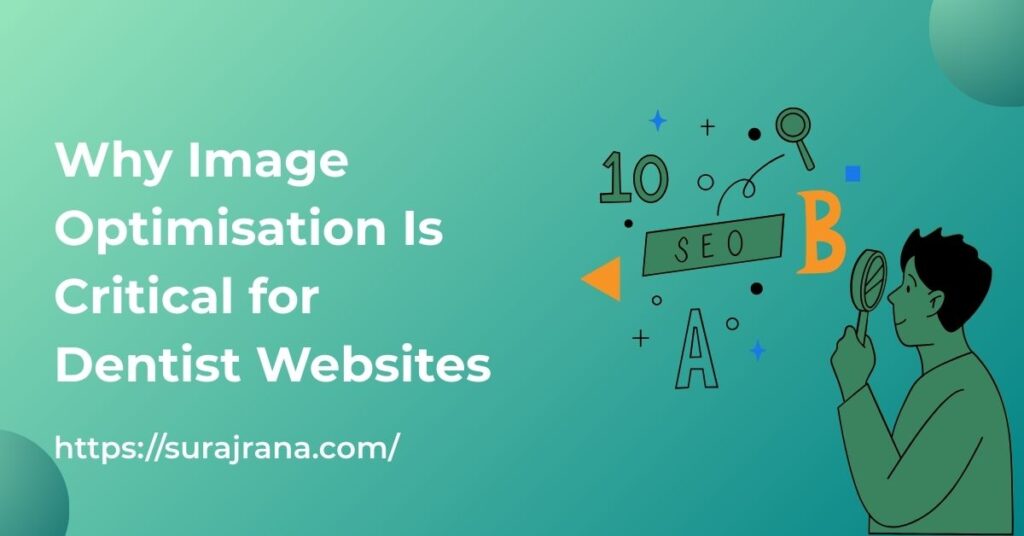In today’s fast-paced digital world, first impressions matter—especially online. For dentists trying to attract new patients through their websites, a fast-loading, visually appealing site can be the deciding factor between a new booking and a bounce.
One often overlooked yet critical component of a high-performing dental website is image optimisation.
Whether it’s showcasing before-and-after photos, high-resolution images of your dental clinic, or informative diagrams, images are a powerful tool to communicate trust and professionalism.
However, if not optimised properly, they can also be a major reason for poor site performance, bad user experience, and lower search engine rankings.
This article explores why image optimisation is essential for dentist websites, how it affects site speed and SEO, and practical strategies you can implement right away.
1. The Role of Images in a Dentist’s Website
A dental website is often the first point of contact between a practice and a potential patient. High-quality visuals can convey cleanliness, professionalism, and competence—traits every patient looks for in a dental clinic.
Working with a Local SEO for Dentists can help ensure these visuals are not only appealing but also fully optimised to boost your website’s visibility and performance.
Images serve several purposes:
- Trust-building: Real photos of your dental team, office space, and actual patients (with consent) create a genuine connection.
- Education: Infographics and diagrams help explain complex dental procedures in an easy-to-understand way.
- Promotion: Before-and-after photos of cosmetic or restorative procedures highlight the quality of your work.
While all of this enhances user experience, the technical side—such as how these images are loaded and displayed—determines how effective they truly are.
2. How Image Optimisation Affects Website Speed
Website speed is a major ranking factor in Google’s algorithm. A study by Google found that 53% of mobile users abandon a site that takes longer than 3 seconds to load.
One of the biggest culprits for slow-loading websites? Unoptimised images.
Large image files can:
- Increase page load time
- Consume more bandwidth
- Reduce mobile usability
If your website features high-resolution images that are not compressed or resized appropriately, they can drag down your entire site performance.
This leads to a frustrating experience for users, especially those on slower mobile networks.
3. Impact on SEO Rankings
Search engines like Google care deeply about user experience, and page load speed is a huge part of that.
When your images are not optimised, and your site loads slowly, it affects your SEO in several ways:
- Lower rankings in search engine results pages (SERPs)
- Higher bounce rates
- Lower dwell time
In addition, image optimization itself offers SEO opportunities. Properly named image files, descriptive alt text, and structured data help search engines understand the content of your images.
This can improve visibility in image searches and contribute to overall on-page SEO. When integrated with a broader SEO Plans for Dentists strategy, image optimisation becomes even more powerful.
By combining it with other techniques under bold SEO for dentists, you enhance your chances of reaching more potential patients online.

4. Mobile-First Indexing and Image Performance
Google has switched to mobile-first indexing, meaning the mobile version of your website is now the primary version used for ranking.
Given that mobile users are typically on slower connections, having poorly optimised images can be especially harmful.
Responsive images that adjust based on screen size are essential. Formats like WebP, which provide high-quality visuals at smaller file sizes, are also recommended.
Without proper image optimisation, you risk alienating a huge segment of your audience—mobile users—who are more likely to be searching for a dentist on the go.
5. Best Practices for Image Optimisation on Dental Websites
Here are some actionable tips to optimise images on your dental practice website:
a. Use the Right File Type
- JPEG: Ideal for photographs.
- PNG: Best for transparent images and graphics.
- WebP: Offers excellent compression and quality—preferred by Google.
b. Resize Images
Avoid uploading large, high-resolution images and relying on HTML or CSS to scale them down, as this still forces browsers to load the full file size.
Instead, resize your images to the exact dimensions needed for your website’s design before uploading.
This reduces page weight, improves loading speed, and creates a more efficient, user-friendly browsing experience—especially important for dental websites where fast access to service information matters.
c. Compress Image Files
Use image compression tools like TinyPNG or ImageOptim to significantly reduce file sizes without sacrificing visual quality.
These tools strip unnecessary data from image files, allowing your dental website to load faster while still looking professional.
Faster load times not only enhance user experience but also support stronger SEO performance by reducing bounce rates and improving site speed metrics..
d. Implement Lazy Loading
Lazy loading is a technique that defers the loading of images until they enter the user’s viewport—meaning the browser only loads images when they’re actually needed.
This reduces the amount of data loaded during the initial page render, resulting in faster page load times and a smoother browsing experience.
For dental websites, implementing lazy loading helps ensure potential patients aren’t slowed down when accessing key information, especially on mobile devices or slower connections.
e. Add Descriptive File Names
Rather than using generic file names like “IMG_1234.jpg,” rename your images with descriptive, keyword-rich titles such as “dental-cleaning-before-after.jpg.”
This small step makes a big difference—helping search engines understand the content of your images more clearly and improving your chances of appearing in relevant image search results.
For dental websites, using meaningful image names also reinforces your SEO strategy and makes your content more discoverable.
f. Use Alt Text
Alt text not only improves accessibility for users who rely on screen readers but also plays a key role in helping search engines understand the content and context of your images.
By providing clear, descriptive alt text, you make your website more inclusive while also increasing the chances of your images appearing in Google Image search results—driving additional traffic to your dental website and supporting your overall SEO efforts.
g. Leverage Content Delivery Networks (CDNs)
Content Delivery Networks (CDNs) host images on multiple servers distributed across various geographic locations, which helps deliver content from the server closest to each user.
This significantly reduces load times, no matter where someone is accessing your dental website from, leading to a smoother, faster browsing experience that benefits both user satisfaction and SEO performance.
6. User Experience: Beyond Just Speed
Optimised images not only load faster but also look better across all devices. Crisp, clear visuals make your website more engaging and professional.
For dentists, this is crucial. A poorly presented image can do more harm than good, especially when you’re trying to showcase your skills and instill confidence in your services.
Enhanced user experience also leads to:
- Longer time on site
- Increased interaction
- More appointment bookings
All of which signal to Google that your site is valuable and relevant—factors that further boost SEO.
7. Image Optimisation and Local SEO
Most dental practices rely heavily on local clients. Optimised images can play a key role in your local SEO strategy. Here’s how:
- Geotagging images: Embedding location data in your image metadata can reinforce local relevance.
- Google Business Profile: Uploading optimised images to your Google Business profile improves engagement and may increase your visibility in local searches.
- Schema Markup: Using structured data to label images can help Google display them more prominently in local search features.
Combined with SEO for dentist tactics like Google Maps optimisation and local citation building, well-optimised images help paint a complete and compelling online presence.
8. Common Mistakes to Avoid
Even with the best intentions, many dental websites make critical mistakes with their image use:
- Uploading stock photos that don’t represent the actual practice
- Using overly large or uncompressed images
- Forgetting alt text or using generic alt descriptions
- Not testing image load times on mobile devices
- Ignoring image SEO opportunities like file names and captions
Avoiding these pitfalls can significantly enhance both user experience and search engine performance.
9. Tools and Plugins for Image Optimisation
Depending on your website platform, several tools can help you streamline image optimisation:
For WordPress:
- Smush: Automatically compresses and resizes images.
- ShortPixel: Offers WebP conversion and CDN integration.
- Imagify: A lightweight tool for compressing images with minimal quality loss.
Standalone Tools:
- TinyPNG or JPEGmini for manual image compression
- Cloudinary or ImageKit for advanced optimisation and delivery
These tools simplify the process, making it easy to maintain fast, visually appealing, and SEO-friendly dental websites.
10. Image Optimisation as Part of a Bigger Strategy
Image optimisation should not be treated as an isolated task. It’s a core part of your broader digital marketing and SEO strategy. When integrated properly, it helps:
- Improve loading times
- Enhance SEO
- Support accessibility
- Boost conversion rates
Whether you manage your site yourself or work with a digital marketing agency, ensuring that your images are properly optimised can yield long-term benefits. It’s one of those “small hinges that swing big doors.”
Conclusion
For dentist websites, image optimisation is far more than a technical requirement—it’s a strategic advantage.
From improving page speed and search engine rankings to enhancing user experience and building trust, optimised images do heavy lifting in multiple areas.
By taking the time to choose the right formats, compress and resize images, add meaningful alt text, and implement best practices, you’ll create a website that not only looks great but also performs exceptionally well.
When paired with a comprehensive approach to bold SEO for dentist strategies, such as those offered by Suraj Rana SEO, image optimisation becomes a powerful tool in helping your practice stand out in a competitive local market.

My name is Suraj Rana, and I am a seasoned Dental SEO Specialist with extensive experience in the Dental SEO industry. Leveraging my deep knowledge and expertise, I help dental practices enhance their online visibility and attract more patients.


